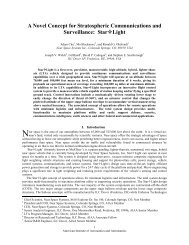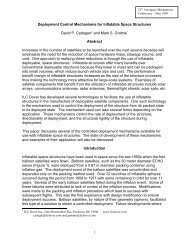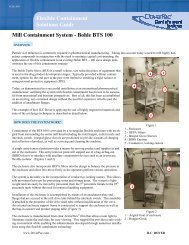Self-Healing Technology for Gas Retention Structures ... - Team-Logic
Self-Healing Technology for Gas Retention Structures ... - Team-Logic
Self-Healing Technology for Gas Retention Structures ... - Team-Logic
- No tags were found...
Create successful ePaper yourself
Turn your PDF publications into a flip-book with our unique Google optimized e-Paper software.
etween slides with manual pressure to visualize contentrelease. Micrographs are shown in Figure 13.WHOLE MICROCAPSBURST MICROCAPSFigure 13. Microcapsules Filled with Red DyeFigure 11. Closed Cell Foam Laminate with ViscoelasticGelMACROENCAPSULATED CHEMICAL REACTANTSSample specimens with A and B reactants contained inseparate layers were fabricated. Various reactants wereevaluated. Initial screening tests at 34.5 kPa with a 2 mmpuncture probe showed fast reaction times. Highviscosity reactants showed the best results. Figure 12shows the foaming reaction of a macroencapsulatedchemical reactant sample.A film that contained the microcapsules wasmanufactured with a nominal thickness of .051 - .076mm. The microcapsules were exposed to solvents andthermal sealing processes used in the manufacture offilms and laminates to evaluate the durability of thecapsules. It was concluded that the microcapsules havea lower than desired survivability after processing and,given the need <strong>for</strong> a thin shell wall so as to easily releasethe reagents with a destructive impact, it is not expectedthat a thicker walled structure would function as well toimpact threats.A significant variation in the size of the microcapsuleswas also found to exist. The size of the microcapsuleswas demonstrated in comparison to a 2 mm defect andfound to be insufficient. See Figure 14.2mmholeEntrainedAirRed DyedMicrocapsFigure 14. Microcapsule Size in Relation with DefectFigure 12. Macroencapsulated Chemical Reactant <strong>Self</strong>-<strong>Healing</strong> SampleMICROENCAPSULATED CHEMICAL REACTANTSTo begin this evaluation, blank (dummy) microcapsulescontaining red dye <strong>for</strong> improved visualization weremanufactured at University of Illinois-Champaign. ILCDover evaluated the capsules as though they were filledwith self-healing reactants to better understand theircapabilities in this sort of application. The nominalcapsule size was 55 microns. Microcapsules were burstThe size of microcapsule and degree of loading thatwould be needed to effectively fill a 2 mm defect wasanalyzed. Assuming a .07 kg/m 2 encapsulated selfhealingcomposite, and 5-10% loading of microcapsulesper weight, it was determined that microcapsules in the400 micron range would be required to provide sufficientdensity of foam to fill a 2 mm defect.Larger microcapsules (200 - 120 micron) were readilyavailable and were manufactured into another filmsample loaded to an equivalent 10% by weight.Microscopic evaluation confirmed that larger capsuleswould be required to have a fully functional self-healingbladder material.













